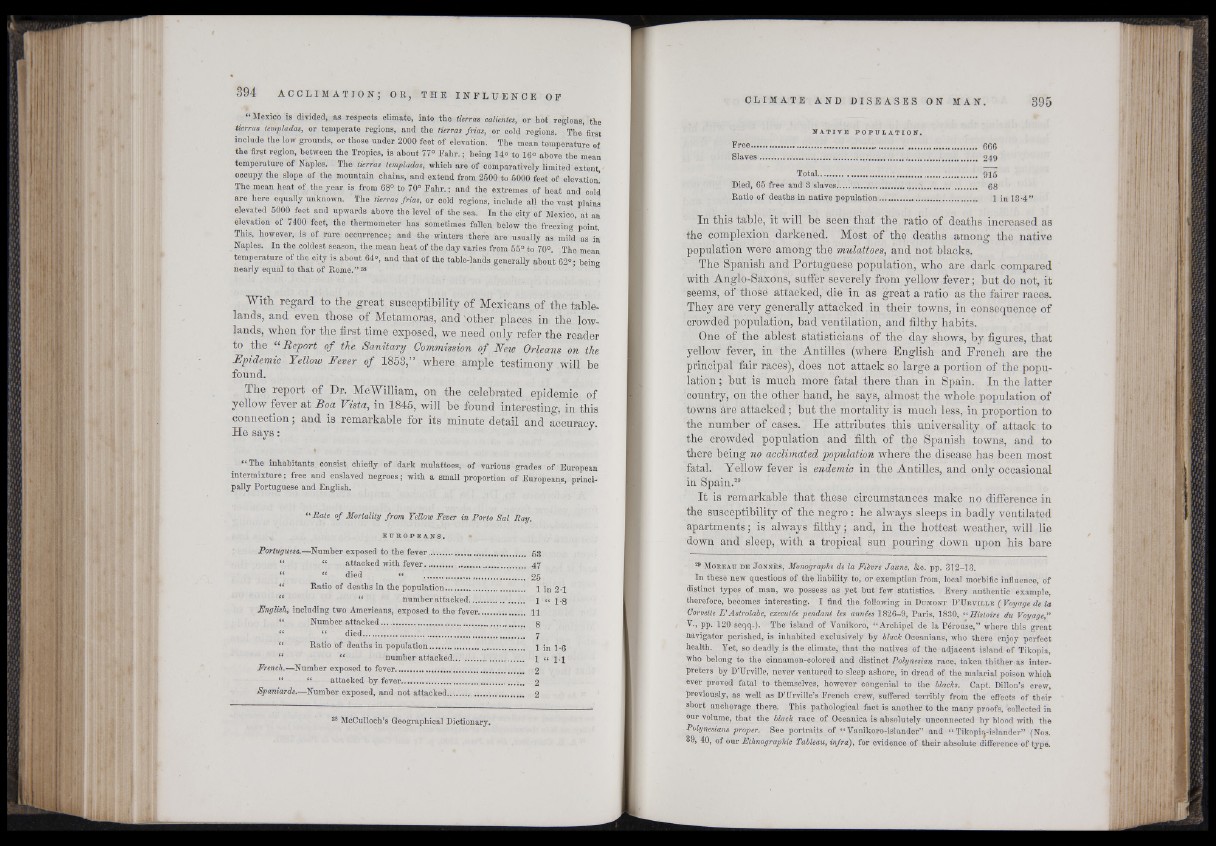
“ Mexico is divided, as respects climate, into the tierras calientes, or hot regions, the
tierras templadas, or temperate regions, and the tierras frias, or cold regions. The' first
inolude the low grounds, or those under 2000 feet of elevation. The mean temperature of
the first region, between the Tropics, is about 77° Fabr. ; being 14» to 16° above the mean
temperature of Nitples. The tierras templadas, which are of comparatively limited extent,
occupy the slope of the mountain chains, and extend from 2500 to 5000 feet of elevation.
The mean heat of : the year is from 68» to 70° Fahr. ; and the extremes of heat and cold
are here equally unknown. The tierras frias, or cold regions, include all the vast plains
elevated 5000 feet and upwards above the level of the sea. In thè city of Mexico, at an
elevation of 7400 feet, the thermometer has sometimes fallen below the freezing'point.
This, however, is of rare occurrence; and the winters there are usually as mild as in
Naples. In the coldest season, the mean heat of the day varies from 55° to 70°. ~ The mean
temperature of the city is about 64°, and that of the table-lands generally about 62°; being
nearly equal to that of Rome.” 28
With regard to the great susceptibility of Mexicans of the tablelands,
and even those of Metamoras, and 'other places in the lowlands,
when for the first time exposed, we need only refer the reader
to the “ Report of the Sanitary Commission of New Orleans on the
Epidemic Yellow Fever of 1853,” where ample testimony will he
found.
The report of Dr. McWilliam, on the celebrated epidemic of
yellow fever at Boa Vista, in 1845, will be found interesting, in this
connection ; and is remarkable for its minute detail and accuracy.
He says : '
“ The inhabitants consist chiefly of dark mulattoes, of various grades of European
intermixture; free and enslaved negroes; with a small proportion of Europeans, princi-
pally Portuguese and English.
“ Rate of Mortality from Yellow Fever in Porto Sal Ray.
E U R O P E A N S .
Portuguese.—Number exposed to the f e v e r ........................ 53
“ “ attacked with fever........................... 47
“ “ died “ 25
" Ratio of deaths in the population..................................... 1 in 2 1
** « number attacked.......... ....... . 1 « j.g
English, including two Americans, exposed to the fever..................... 11
Hi Number attacked...................... 8
“ “ died ............... 7
“ Ratio of deaths in population........................................... 1 jn j .g
“ number attacked... ! 1 << 1-1
French.—Number exposed to fever....................................... o
“ “••• • attacked by fever....... ......... ......... ¿¿.'i.. 2
Spaniards.—Number exposed, and not attacked..................................... 2
28 McCulloch’s Geographical Dictionary.
N A T I V E P O P U L A T I O N .
Free...................... ......; ...................................... 666
Slaves,............................. ..................................1 .......... 249
Total ............ 915
Died, 65 free and 3 slaves................................mfm .......... 68
Ratio of deaths in native population......................................... ... 1 in 13*4”
In this table, it will be seen that the ratio of deaths increased as
the complexion darkened. Most of the deaths among the native
population were among the mulattoes, and not blacks.
The Spanish and Portuguese population, who are dark compared
with Anglo-Saxons, suffer severely from yellow fever; but do not, it
seems, of those attacked, die in as great a ratio as the fairer races.
They are very generally attacked in their towns, in consequence of
crowded population, bad ventilation, and filthy habits.
One of the ablest statisticians of the day shows, by figures, that
yellow fever, in the Antilles (where English and French are the
principal fair races), does not attack so large a portion of the population
; but is much more fatal there than in Spain. In the latter
country, on the other hand, he says, almost the whole population of
towns are attacked; but the mortality is much less, in proportion to
the number of cases. He attributes this universality of attack to
the crowded population and filth of the Spanish towns, and to
there being no acclimated population where the disease has been most
fatal. Yellow fever is endemic in the Antilles, and only occasional
in Spain.29
It is remarkable that these circumstances make no difference in
the susceptibility of the negro: he always sleeps in badly ventilated
apartments; is always filthy; and, in the hottest weather, will lie
down and sleep, with a tropical sun pouring down upon his bare
29 M o r e a u d e J o n n ís , Monographe de la Fierre Jaune, &c. pp. 312-13.
In these new questions of the liability to, or exemption from, local morbific influence, of
distinct types of man, we possess as yet but few statistics. Every authentic example,
therefore, becomes interesting. I find the following in D umont D ’U r v il l e ( Voyage de la
Corvette L'Astrolabe, execulée pendant les années 1826-9, Paris, 1830, “ Eistoire du Voyage,"
V., pp. 120 seqq.). The island of Vanikoro, “ Archipel de la Pérouse,” where this great
navigator perished, is inhabited exclusively by black Oceanians, who there enjoy perfect
health. Yet, so deadly is the climate, that the natives of the adjacent island of Tikopia,
who belong to the cinnamon-colored and distinct Polynesian race, taken thither as interpreters
by D’Urville, never ventured to sleep ashore, in dread of the malarial poison which
ever proved fatal to themselves, however congenial to the blacks. Capt. Dillon’s crew,
previously, as well as D’Urville’s French crew, suffered terribly from the effects of their
short anchorage there. This pathological fact is another to the many proofs, collected in
our volume, that the black race of Oceánica is absolutely unconnected by blood with the
Polynesians proper. See portraits of “ Vanikoro-islander” and “ Tikopia-islander” (Nos.
39, 4:0, of our Ethnographic Tableau, infra), for evidence of their absolute difference of type.